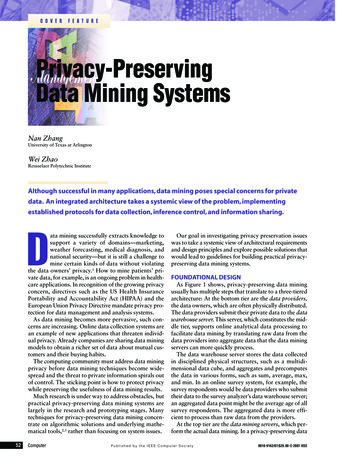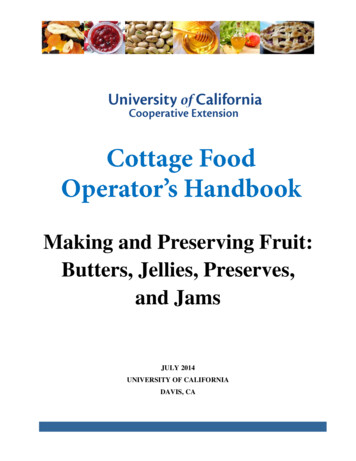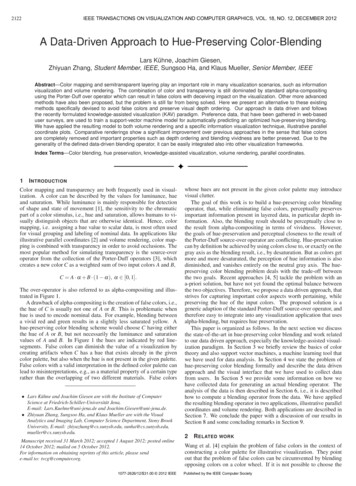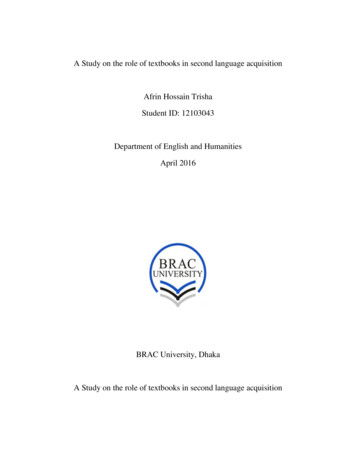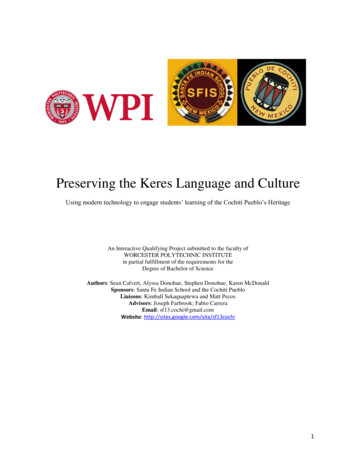
Transcription
Preserving the Keres Language and CultureUsing modern technology to engage students’ learning of the Cochiti Pueblo’s HeritageAn Interactive Qualifying Project submitted to the faculty ofWORCESTER POLYTECHNIC INSTITUTEin partial fulfillment of the requirements for theDegree of Bachelor of ScienceAuthors: Sean Calvert, Alyssa Donohue, Stephen Donohue, Karen McDonaldSponsors: Santa Fe Indian School and the Cochiti PuebloLiaisons: Kimball Sekaquaptewa and Matt PecosAdvisors: Joseph Farbrook; Fabio CarreraEmail: sf13.cochi@gmail.comWebsite: http://sites.google.com/site/sf13cochi1
AuthorshipSectionAuthorsReviewers1. IntroductionStephen, Alyssa, Karen, SeanStephen, Alyssa, Karen, Sean2. BackgroundAlyssaStephen, Alyssa, Karen, Sean2.1 Languages of the WorldAlyssaStephen, Alyssa, Karen, Sean2.2.1 What Defines a CultureSean and KarenStephen, Alyssa, Karen, Sean2.2.2 How Spanish Conquestand Pueblo Rebellion Shapedthe Culture at the CochitiPuebloKarenStephen, Alyssa, Karen, Sean2.2.3 Development of CultureAfter the Cochiti Dam ProjectKarenStephen, Alyssa, Karen, Sean2.3 Heritage PreservationSeanStephen, Alyssa, Karen, Sean2.4 Keres LanguagePreservationKarenStephen, Alyssa, Karen, Sean2.5 Keres Programs TodayKarenStephen, Alyssa, Karen, Sean2.6 Digital Tools in CulturalPreservationSean and StephenStephen, Alyssa, Karen, Sean2.7 Child Development andCultural Preservation in thePuebloKaren and SeanStephen, Alyssa, Karen, Sean3. MethodologyAlyssaStephen, Alyssa, Karen, Sean3.1 Developing CulturallyRelevant IdeasAlyssaStephen, Alyssa, Karen, Sean3.1.1 Visiting the PuebloAlyssaStephen, Alyssa, Karen, Sean3.1.2 Observation in theCochiti SchoolsAlyssaStephen, Alyssa, Karen, Sean3.2 Creating Keres LanguageMediaAlyssaStephen, Alyssa, Karen, Sean2
3.2.1 Creating InteractiveAudio Flash CardsAlyssaStephen, Alyssa, Karen, Sean3.2.2 Dubbing Cartoons inKeresAlyssaStephen, Alyssa, Karen, Sean3.2.3 Animating Children’sStoriesAlyssaStephen, Alyssa, Karen, Sean3.3 Demonstrating toAlyssaTeachers and Students How toCreate Their Own MediaStephen, Alyssa, Karen, Sean3.3.1 Teaching Students at theSanta Fe Indian SchoolAlyssa and SeanStephen, Alyssa, Karen, Sean3.3.2 Leaving Behind TutorialsSeanStephen, Alyssa, Karen, Sean3.4 Creating a Hub of all KeresMediaStephenStephen, Alyssa, Karen, Sean3.4.1 Creating the CochitiSpeaks Website and YouTubeStephenStephen, Alyssa, Karen, Sean4. Results and AnalysisKaren and AlyssaStephen, Alyssa, Karen, Sean4.1 Immersion in the Cultureand LanguageKarenStephen, Alyssa, Karen, Sean4.1.1 Cochiti CulturalPreservationKarenStephen, Alyssa, Karen, Sean4.2 Observations from theClassesKarenStephen, Alyssa, Karen, Sean4.3 Survey ReslltsKarenStephen, Alyssa, Karen, Sean4.4 Flash CardsKaren and StephenStephen, Alyssa, Karen, Sean4.5 Turning Traditional Storiesinto Animated MoviesSean and KarenStephen, Alyssa, Karen, Sean4.6 Dubbing in KeresKarenStephen, Alyssa, Karen, Sean4.7 WebsiteStephenStephen, Alyssa, Karen, Sean4.8 TutorialsKarenStephen, Alyssa, Karen, Sean3
5. Recommendations forExpansionSeanStephen, Alyssa, Karen, Sean6. BibliographyStephen, Alyssa, Karen, SeanStephen, Alyssa, Karen, Sean4
AcknowledgementsWe initially would like to thank our two sponsors, the Cochiti Pueblo and the SantaFe Indian School. We thank Cochiti for giving us this amazing opportunity to experienceyour culture and language, and hope to have done justice to them through our project. Wewould also like to thank the Santa Fe Indian School for allowing us access to all of yourvarious buildings and technologies for the success of our project.Specifically we would like to thank Kimball Sekaquaptewa, the IT Coordinator at theSanta Fe Indian School and also one of our liaisons. She has put so much into this projectand we absolutely could not have gotten as far as we have without her guidance andknowledge. We cannot even begin to list everything she has done for us personally and forour project.We would also like to thank Matt Pecos the Community Based Education Liaison atthe Santa Fe Indian School and also our second liaison for our project. He helped usestablish close ties with the Cochiti Pueblo, enhancing our project extensively. He also wasone of the main contributors for our voiceovers in Keres and we cannot thank him enoughfor lending us his acting skills for the creation of our media.Finally at the Santa Fe Indian School, we would like to thank Tony Herrera and hisCochiti Keres class for letting us use their class time and their voices for various parts ofour projects. We hope all of you had a blast, we enjoyed working with you! In addition tothose at the Santa Fe Indian School we would also like to thank Lorencita Taylor and herclass at Bernalillo for letting us get recordings from you and letting us sit in on your class.A special thank you to all of Kimball’s family at the Cochiti Pueblo especially Da-oohShrees for accommodating us and teaching us so much about your culture and language.We will miss you all and we have learned so much!We would like to especially thank Fabio Carrera and Joseph Farbrook for giving usthe opportunity to work on this wonderful and fulfilling project. We have gained someamazing experiences and cannot express enough gratitude for everything you haveprovided for us.5
AbstractThis project involved preserving the Keres language and culture at the CochitiPueblo through the subversion of English media into Keres versions. Examples of the mediawere produced and tools were left behind to encourage further production. A hub for all ofthe Keres media was created to contain all of the created media for ease of access. Overallwe hope that our project progresses over the years so that eventually there is anabundance of Keres media in the pueblo.6
Executive SummaryOur project worked to address English media pushing out the Keres language andculture of the Cochiti Pueblo. We tried to counteract this by subverting the English mediaby dubbing popular children’s cartoons, creating animated movies relevant to culturalsongs and stories, creating flash cards with Keres translations to match the images, andproducing a website that will hold all of the above in addition to tutorials so that people cancontinue our work in the future . There are great programs already in place at the CochitiPueblo, such as the Nest Program and the Keres Children Learning Center, that provideimmersion classes for the children of the pueblo and Keres classes at the local Santa FeHigh School. This is why our project focuses on bringing tools to these programs; in orderto help them better engage students and create a strong desire to learn Keres, and to allowthem to continue to learn Keres while they are at home. Based on this our four mainobjectives were: Developing production ideas for the creation of culturally relevant media. Producing examples and media models specific to the Keres language andculture. Demonstrating learning tools to teachers and students through the creationof tutorials and offer guidance for new concepts. Creating a website and media channel and a hub of Keres language learningAfter finalizing these objectives we worked on creating demos and mock-ups toshow the students. For our demos, we were each able to create a few examples of our givenmedia. The bulk of our results came from both our own creations as well as the creations ofthe students that we worked with at the Santa Fe Indian School. We created sets of flashcards from sketches found at the Cochiti Library as well as audio recorded from theteachers and students at the Santa Fe Indian School. These flash cards were divided intodifferent categories, audio was recorded, and they were matched with appropriatesketches. We created multiple animated stories from sketches to replicate various storiesand songs from the Cochiti culture, including the story of the Fox and the Prairie Dogs and7
the Duck Song. These examples were created to provide the Keres classes at both the NESTprogram and the Keres Children Learning Center with initial media to use in theirclassrooms until the Hub became more populated. In addition to the animated stories, ourgroup dubbed cartoon videos in Keres were created as examples for the students. An entireepisode of Spongebob Squarepants was dubbed into Keres with help from the very talentedlanguage teachers and students at the Santa Fe Indian School. In addition to this episode, aDisney montage comprised of scenes from the Lion King, Finding Nemo, and Toy Story 3was dubbed into Keres as well. By bringing new ways to create media we were able toshow the people of Cochiti the endless possibilities using programs already on theircomputers.After showing our examples and demos to the Cochiti Keres students and teachersat the Santa Fe Indian School, our next step was to demonstrate to them how to create theirown media. We taught classes on how to use various programs that aided in the creation ofour media including Audacity, Adobe Premiere, and Adobe Flash. Once the students had abasic understanding of how to operate these programs, we gave them the pieces theyneeded to create their own media. With both the help from their Keres teachers fortranslations and us for technical support, they were able to produce their own media whilelearning Keres in the process. Along with teaching the current Keres class at the Santa FeIndian School, we also created Camtasia recordings of ourselves using the previously listedcomputer programs in order to create viable tutorials to leave behind for when we leave.All of the above media and tutorials were then placed on our Cochiti Speaks Websiteor “KeresTube” YouTube channel. These websites were created in order to keep all of ourcreations and all future creations in one accessible place. We made sure that both werecompletely private by making them password protected so that the people of Cochiti couldshare these with only those they wanted to. The login information was shared with thevarious schools in Cochiti and the Santa Fe Indian School so that students could have accessto the existing media there as soon as possible. Since the Keres Language is so directlylinked to the culture of the Cochiti Pueblo, it is important to preserve the language to makesure the culture will not also be threatened with extinction.With the results we achieved while in Santa Fe, we have high hopes for theprogression of our project after we leave. By leaving behind instructions and templates, we8
hope that our hub of Keres media will continue to grow as the years go on. The highinterest and positive feedback that we have received from this project has given usconfidence that our project will continue to evolve and take shape even without us here. Inthe long run, we are hoping that the hub will be populated to the extent that the mediathere will replace the existing English media, giving parents and teachers the option ofsolely using Keres media in the homes and classrooms.9
Table of ContentsAcknowledgements. 5Abstract . 6Executive Summary. 71. Introduction . 122. Background . 142.1 Languages of the World . 142.2.1 What Defines a Culture . 152.2.2 How Spanish Conquest and Pueblo Rebellion Shaped the Culture at the Cochiti Pueblo . 152.2.3 Development of Culture After the Cochiti Dam Project . 172.3 Heritage Preservation . 182.4 Keres Language Preservation. 192.5 Keres Programs Today . 202.6 Digital Tools in Cultural Preservation . 222.7 Child Development and Cultural Preservation in the Pueblo . 233. Methodology . 253.1 Developing Culturally Relevant Ideas . 253.1.1 Visiting the Pueblo . 263.1.2 Observation in the Cochiti Schools . 283.2 Creating Keres Language Media. 303.2.1 Creating Interactive Audio Flash Cards . 303.2.2 Dubbing Cartoons in Keres . 313.2.3 Animating Children’s Stories. 333.3 Demonstrating to Teachers and Students How to Create Their Own Media . 353.3.1 Teaching Students at the Santa Fe Indian School . 353.3.2 Leaving Behind Tutorials. 373.4 Creating a Hub of all Keres Media . 383.4.1 Creating the Cochiti Speaks Website and YouTube . 384. Results and Analysis . 394.1 Immersion in the Culture and Language . 404.1.1 Cochiti Cultural Preservation . 424.2 Observations from the Classes . 434.3 Survey Results . 444.4 Flash Cards. 454.5 Turning Traditional Stories into Animated Movies . 4510
4.6 Dubbing in Keres . 474.7 Website . 484.8 Tutorials . 495. Recommendations for Expansion . 506. Bibliography . 52Appendix . 5411
1. IntroductionThe United States has been known as the world’s “melting pot” as it combinesnumerous cultures and languages. While this term originally indicated a positive meaning, inthe current era it more accurately represents losing one’s culture and native language withinthe conformity of the “melting pot”. The hope is thatAmerica will move towards becoming a “salad bowl”,where everything is mixed in but is able to keep its ownidentity. Approximately 337 languages are spoken withinthe United States, 176 of which are consideredindigenous. Compared to the 92% of people in the UnitedStates that fluently speak either English or Spanish, the percentage that speaks any otherlanguage is minuscule. Because of this, media in theUnited States is dominated by the English language, whichimpacts the development of children exposed to thismedia. Minor languages then easily fall behind and are lostto the younger generations in favor of English. WithEnglish being the dominant language of the United States,other languages face the possibility of extinction in thenear future.Indigenous languages still exist despite the dwindling numbers of fluent speakers.Within New Mexico alone, there are nineteen pueblos which possess unique cultures andcommunicate using five distinct languages. Despite the fact that these five pueblo languageshave avoided extinction to this date, the future of their existence is threatened. Most of thefluent speakers within these pueblos are members of the older generations. Due to this, therate at which these indigenous languages are approaching extinction is increasing. Thestartlingly low number of fluent speakers of these languages indicates a likelihood of themgoing extinct in the near future.12
Specifically our group is working with the Kereslanguage, spoken at the Cochiti Pueblo. Keres is dyingout as shown in fewer fluent speakers are beingproduced each year especially among the youngergenerations, so much so that there are only 100 fluentspeakers left. One of the reasons there is a decline influency is that the language is not written down and is difficult to teach due to a lack of accessto the language and material on it. Another is that it is challenging to get the youngergeneration interested in learning it. The English language dominates the media viewed by themembers of the pueblo, which is why our project is trying to subvert the English media with aKeres based alternative. Making the cultural media easily accessible to the community at largeis important so that it can continue on for future generations both inside and outside thepueblo.There are already efforts in place within the pueblo to subvert the media. Theseprograms are the the two immersion programs, Nest and Keres Children Learning Center, andthe Keres classes taught at the local high schools. Our group aimed to enhance the programsalready in place by contributing different ideas based in different technologies as alternativeways of teaching. Overall, with the success of our project, we hope that our methods inpreserving Keres will be used as a reference to others exploring methods for preserving theirlanguages.13
2. BackgroundWe will introduce topics researched in preparation for our project. A brief overview ofindigenous languages of the world will be discussed in order to understand the importance andscope of our project. We will then explore different aspects of culture such as heritage andlanguage as well as different ways to preserve a culture if it becomes endangered. Since ourproject involves the development of ways to utilize technology in teaching language andculture, we will also explain how technology itself impacts how a child learns and develops. Inaddition this chapter would discuss what methods that the Cochiti Pueblo already has in placein terms of culture and language preservation.2.1 Languages of the WorldOut of the nearly 7000 languages spoken around the world, roughly 2500 areconsidered seriously endangered1. It is believed that by the year 2100, between 60% and 90%of all languages spoken around the world will be at risk of extinction2. As previouslymentioned, approximately 337 languages are spoken in the United States and of theselanguages, 176 are indigenous. By the year 2050, it is projected that these 176 languages willdiminish to 203. Based this information, itcan be easily concluded that by the year2100, none of these indigenous languageswill exist.On a smaller scale there arenineteen pueblos in New Mexico and fiveof them speak Keres, the focus of our1Huaman, Susan. "Global Media Journal." Global Media Journal. N.p., 2011. Web. 16 Feb. 2013.Romaine, S. 2006. Planning for the survival of linguistic diversity. Language Policy 5,2no. 2: 443-475.3Crawford, J. 2004. Educating English learners: Language diversity in the classroom, 5th3ed. California: Bilingual Educational Services, Inc.214
project. These pueblos are: Santa Domingo, San Felipe, Santa Ana, Zia and Cochiti. All of thesepueblos have slightly different dialects, but they can all roughly understand each other. Ourgroup’s project focused on the revitalization of the dialect of Keres spoken at the CochitiPueblo. Approximately ten percent of the total population at the pueblo is fluent in thelanguage. These numbers are only getting worse because most of these speakers are part theolder generation and the younger generation is not learning the language at the rate that theyonce were. Due to this and the dominance of English language through media in the home, theKeres language is considered an endangered indigenous language.2.2.1 What Defines a CultureA culture can be defined as a set of beliefs, values, and ideas that are shared by adistinct group of individuals, allowing them to function as a whole. Over time, cultures areshaped by their effectiveness in enabling a group of individuals to successfully communicateand thrive. It is essential to preserve cultures since they define a certain population’s identitiesand customs. If cultures are lost, the ultimate end result would be all people being defined byone culture, losing the world’s individuality.The preservation of the Cochiti Pueblo’s culture is the main goal for this project, butthere are multiple aspects that constitute cultural preservation. One major facet of culture isheritage preservation covering the survival of ceremonies, language, traditions, food, etc. Anew aspect is the utilization of digital formats to record the heritage and language of a cultureso that the information is easily accessible to anyone interested in learning about the culture. Alast aspect that we explored is the effort to preserve a culture through child development andlearning.2.2.2 How Spanish Conquest and Pueblo Rebellion Shaped the Culture at theCochiti Pueblo15
Before we look at the methods that have been tried in other cultures around the world,we needed to look at the history and culture in Cochiti itself. The tribe has been living on theland for over a thousand years and has endured colonial excursions from the Spaniards, theMexicans, and the Americans4.The Spanish came to New Mexico to spread the word of god and take control of thefarming people of the pueblos for their own ends. What this meant is that the fundamentals ofboth the religion and culture were pushed underground, causing the pueblo way of life tobecome secretive and highly reclusive5. It was only after eighty two years of Spanishoppression, tensions boiled over and uprisings began within the pueblos.The start of the rebellion was due to Spanish hubris and the banding together of thetribes. There were runners that went around with knotted rope from pueblo to pueblo. Therope was to keep track of the days until the revolt. The pueblo was told by the runners onbehalf of Popay, a Tewa religious leader and leader of the rebellion, to untie a knot each day,and when all the knots are gone to rise up against the Spaniards. Unfortunately for the peopleof the pueblos word got to the Spanish governor that a revolt was happening. The date of therevolt was then moved up, and because the Spanish had grown complacent and believedeverything to be under control, they were unable to stop the pueblos from taking back theirlands. The pueblos drove out the Christian religious leaders and overthrew the families that hadbeen using the people as laborers for their lands. Seven days later 2,500 Native Americans roseup against the Spanish soldiers that had been ruling over their lands and drove them from SantaFe6.To this day at the Cochiti Pueblo there is a ceremony where all the men run toremember the runners that delivered Popay’s message and ropes to the pueblos. In additionthey visit the stronghold where the revolt took place in memory of where their pueblo used tobe and the history behind what was fought for and lost there. The Keres language still has some4Benjamin, Rebecca, Regis Pecos, and Mary Eunice Romero. "Language Revitalization Efforts in the Pueblo DeCochiti: Becoming "Literate" In an Oral Society." In Indigenous Literacies in the Americas: Language Planning fromthe Bottom Up, 115-36: Mouton De Fruyter, 1997.5Romero, Nathan. "About Me and My Language: The Politics of Saving a Vanishing Language." University ofHawaii, Roberts, D. (2004). The Pueblo Revolt. New York: Simon and Schuster Paperbacks.16
Spanish words and phrases due to the conquest. Despite the pueblo people being safe and freefrom this form of oppression, the secrecy from outsiders still remains a part of the culture. Dueto this, access to the language and culture of the pueblo is limited, partly causing the decline inthe language and culture that is seen today.2.2.3 Development of Culture After the Cochiti Dam ProjectCochiti is an oral theocratic society thatconsists of close-knit relationships with the nuclearfamily being of great importance and a largereligious importance placed on the cultivation ofthe land. Due to it being an oral society, there is nowritten language, but instead there is a complexsystem of cultural symbols that are instrumental tothe ceremonial calendar. These symbols areincredibly important in the culture because the society is run from the ceremonial calendar bythe theocratic hierarchy which consists of a religious leader, a war chief, and a war captain.These individuals supervise and lead the ceremonial life of the community7.The society has been threatened and damaged even more in recent times, despiteholding onto their traditions. One of the biggest problems was the building of the Cochiti Damalong the Rio Grande River. The dam created seepage that wiped some of the most sacred sitesof the pueblo, removing some of the ceremonies from the ceremonial calendar. Not only didthe dam take away some of the ceremony grounds, but also flooded and destroyed much of thefarmland. The people of the pueblo are farming people with their own techniques and crops,and by destroying the farm lands this way of life was disrupted for decades. The lack offarmable land caused people to have to relocate to find jobs outside of the pueblo. Due to thiscertain crafts and techniques that were typically made inside of the Cochiti Pueblo now have tobe bought outside of the pueblo for ceremonies and decoration. Also certain crops and7Romero, Nathan17
livestock have to be bought or used sparingly, because it is only recently due to a drainagesystem that farming has started to return to Cochiti. Relocating families caused the kids thatgrew up outside the pueblo to come back with modern and urban ideas about community andeconomic development; many of which went against the traditions of the community 8. Thissplit in ideas caused some of the culture and language to be lost to the American and Hispanicculture.2.3 Heritage PreservationCultural heritage is a very wide field that can encompass a large number of things. Weare considering heritage everything except for the language in a culture. As such this willinclude dances, food, ceremonies, customs, and artifacts that are pertinent to the culture.Many methods have been used previously to preserve the heritage of a culture. Themost effective and applicable of these methods have involved using a classroom setting to getthe children to teach themselves about their heritage by having assignments that involvegathering heritage information. In one such case in Alaska students were given a tape recorderwith the assignment of asking elders in the community about their lives and traditionaltechniques of hunting and cooking and of asking family members how recipes have changedover time9. The researchers then took the recordings and added them to a database so that allof the students could hear what the others had come up with. This method is still young, but itis showing a growth in the interest the children are showing about the traditions of the culture.Another major aspect of preserving a heritage is physically preserving what is alreadythere. Preservation of older items, such as dresses or pottery is almost as essential as teachingthe younger generation how to create items similar to these. This part of heritage preservationis typically done in a museum setting with many trained professionals ma
2.2.1 What Defines a Culture Sean and Karen Stephen, Alyssa, Karen, Sean 2.2.2 How Spanish Conquest and Pueblo Rebellion Shaped the Culture at the Cochiti Pueblo Karen Stephen, Alyssa, Karen, Sean 2.2.3 Development of Culture After the Cochiti Dam Project Karen Stephen, Alyssa, Karen, Sean 2.3 Heritage Preservation Sean Stephen, Alyssa, Karen, Sean




